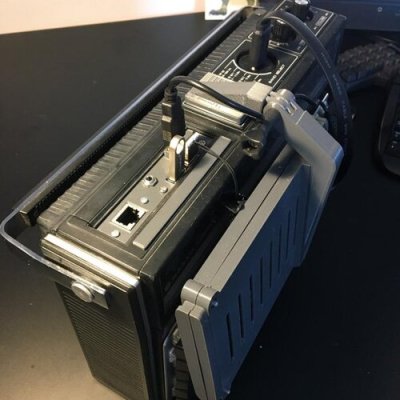Cyberdeck. For those of a certain age, the ‘deck’ part conjures visions of tape decks, be they cassette, 8-track, or quarter-inch, and we seriously have to wonder why haven’t seen this type of build before. But here we are, thanks to [bongoplayingmonkey]’s Sanyo Cyberdeck, a truly retro machine built into a cool old boombox.
 According to [bongoplayingmonkey], this was a unicorn of a build wherein everything more or less came together, soup to nuts. Right now, [bongoplayingmonkey] is cracking the nuts of a few remaining issues, like calibrating the analog VU meter that inspired the build in the first place. The plan is to use that to indicate various analog things such as battery power and the WiFi signal.
According to [bongoplayingmonkey], this was a unicorn of a build wherein everything more or less came together, soup to nuts. Right now, [bongoplayingmonkey] is cracking the nuts of a few remaining issues, like calibrating the analog VU meter that inspired the build in the first place. The plan is to use that to indicate various analog things such as battery power and the WiFi signal.
Luckily, everything survived the teardown, parts-wise. That huge knob has a new life has a rotary encoder for scrolling and middle click. And the VU meter made it too, thank Zod. This baby has full mouse controls thanks to a PS/2 joystick and a pair of vintage momentary buttons are likely chrome and bakelite to round out the look.
So apparently [bongoplayingmonkey]’s personal jury is still out on whether this is a blasphemous build or a divine ‘deck, but we say one thing is for sure: this is definitely art.
Unfortunately, the cassette deck didn’t survive. Otherwise, we might have to question its categorization — is it still a boombox if the tape deck works? This, however, is definitely a laptop that grew up to be a cyberdeck.
Thanks for the tip, [Blasto]!















Makes me think of bolting some sort of “deck” to the bottom of my record player (JVC JL-A1). Something that can house my pre-amp and a small single-board computer which can sample the audio coming out of said pre-amp and dump it on a USB stick as uncompressed 48kHz 16-bit PCM… if I can find a suitable single-board computer with a good audio interface, then I think I could make this work in a very unobtrusive and reversible manner.
Interesting, well the Pi family don’t get great sound without addons, but the audio hats for them are supposed to all be pretty good, though I can only comment on the wolfson cards which are superb at least in every setup I’ve thrown at them but unfortunately discontinued last I looked (Ironically right about the time the software really smoothed out enough to be easy to use it)…
Sticking in the Pi family the CM4 has a PCIe lane available, I’ve not personally tested any audio cards through it yet, will try it at some point – I now have a spare high quality soundcard, its just still bolted into my 400tonne ol’ workhorse tower, so liberating it isn’t easy…
With the size of a record player though got to ask why SBC? Seems like a media centre style mini-ATX or ITX build would fit the bill nicely, and give you much more headroom for audio processing tasks on board (I think a Pi4/CM4 with the right audio device could do all you need easily, but a more normal PC build definitely can (what do you need??)). Sure the x86 media pc is probably more power hogging that battery operation of the whole unit goes out the window, but beyond that seems like the simpler option is sticking with x86 (partly as any audio software you like may not be available or function well on arm – the big open source ones are ok – at least I’ve not found any issues though)
I don’t know quite why but that really makes me want to use such a boom box, or perhaps small reel to reel machine to house a computer and use its magnetic head facilities for backup purposes – which I expect just means finding a more miniature head/heads to increase data density on the standard tape…
For some reason, I kinda like how this looks like
For the blog article: “PS/2 joystick” should be “PS2 joystick” as this is a Sony Playstation 2 type thing, not IBM Personal System/2. I thought this might be using some interesting trackpoint-like joystick module with a PS/2 interface before reading the linked page, but it’s a much more modern analog joystick connected to microcontroller acting as a presumably USB mouse.
Pretty nice project, I’ve kinda always thought of decks as half-boomboxes half-80s computer.
If I had a dollar for every time I thought up a cool project, then saw it the the following day on Hackaday. This has the aesthetic Im looking for, for a shop cyberdeck.
Thanks for the good words.
Add some localisation (gps) and highlight the current position on the top left map somehow (led matrix behind?) :D
The map is printed onto a thin steel insert but I guess a transparent OLED over the top could work?